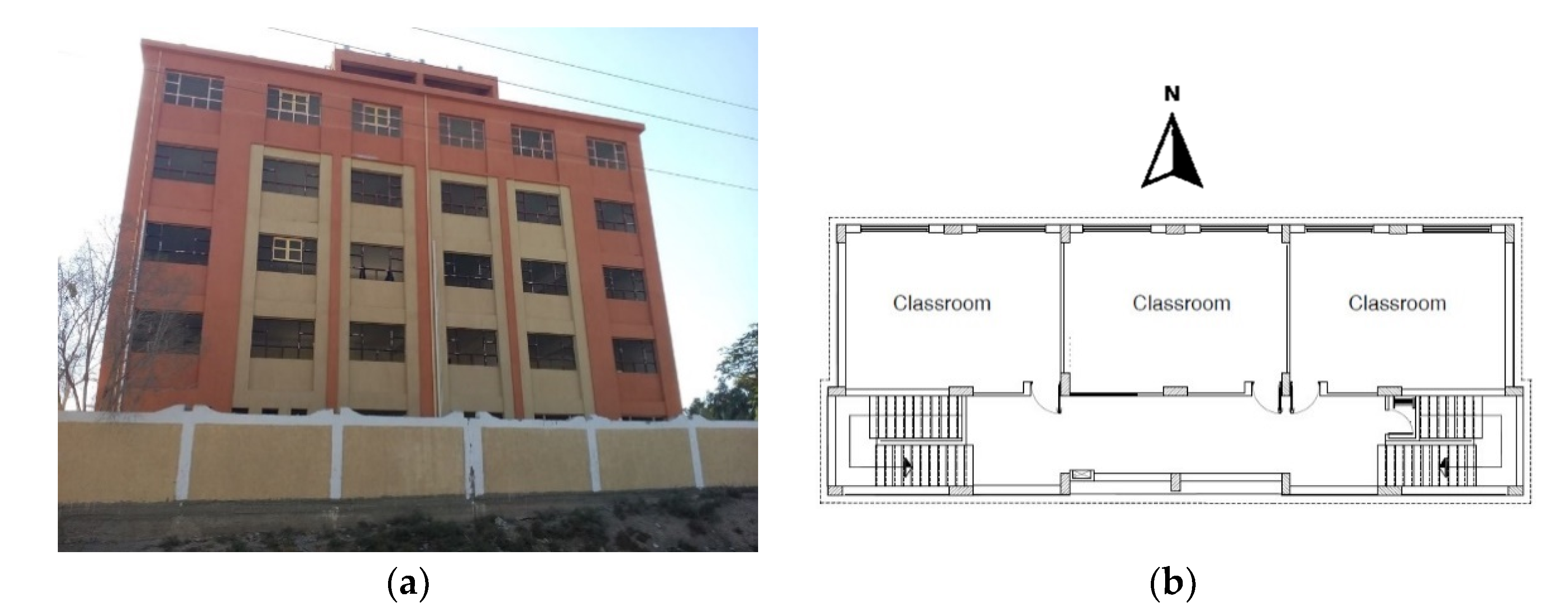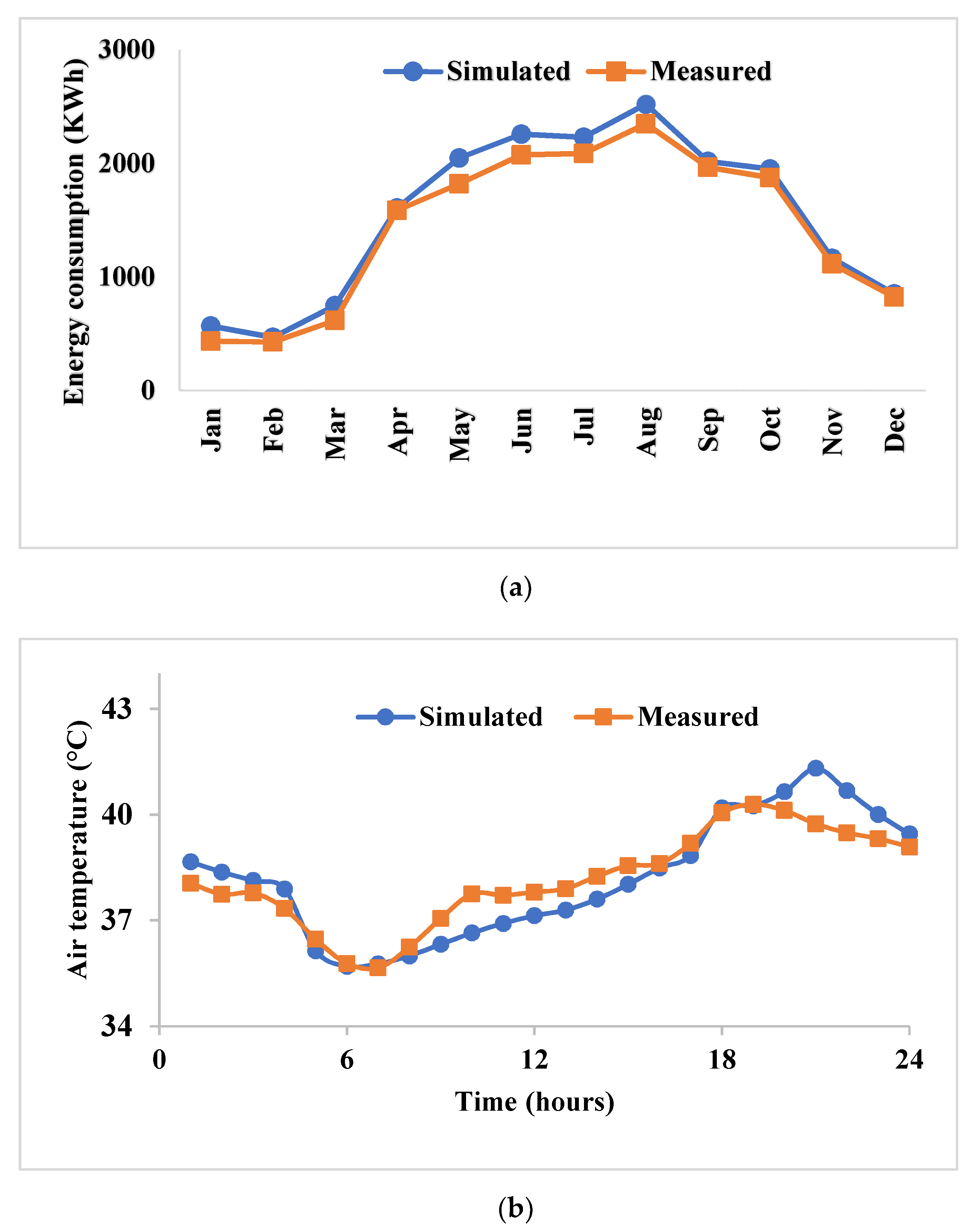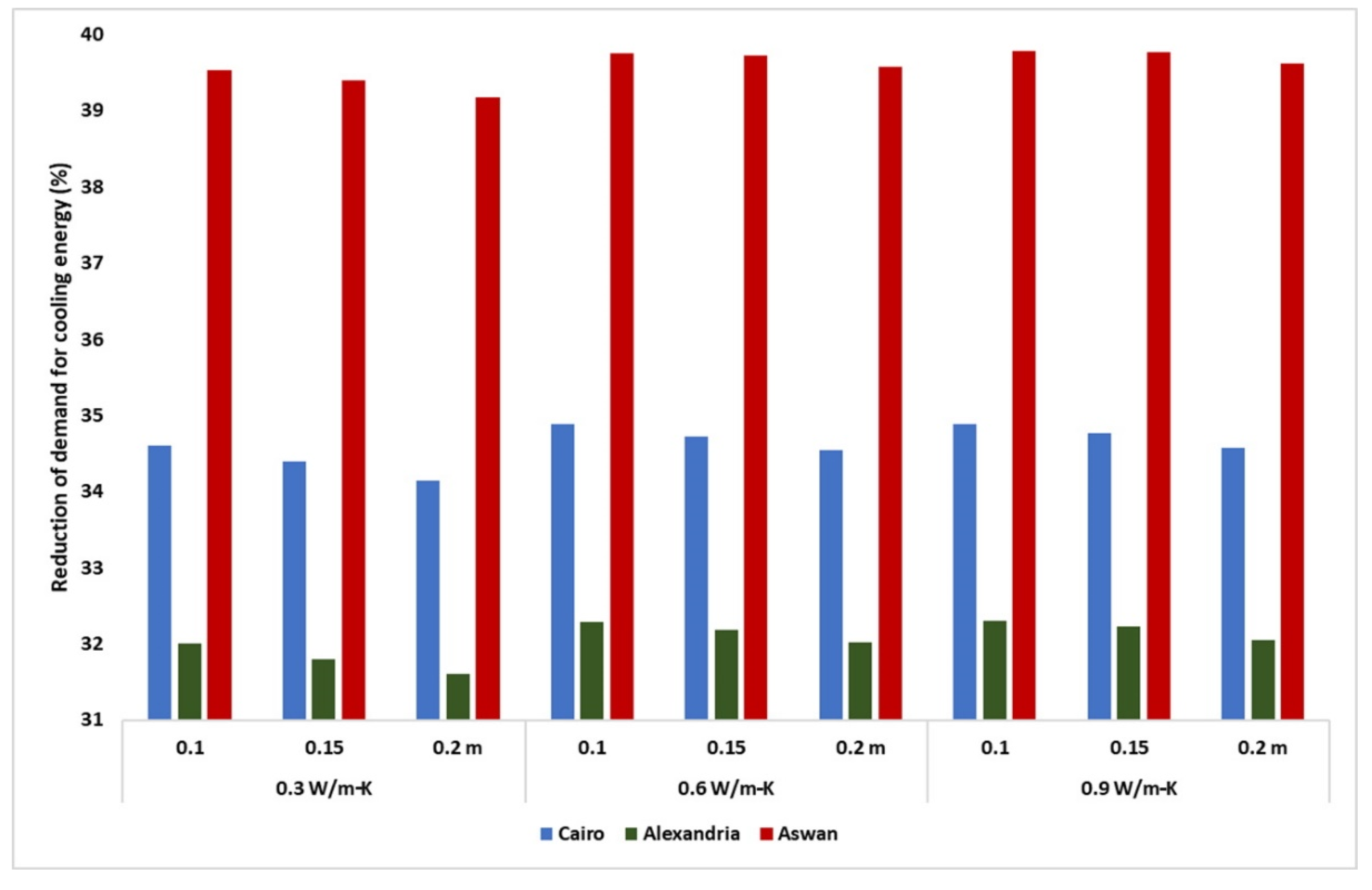Impact of Green Roofs on Energy Demand for Cooling in Egyptian Buildings
Abstract
:1. Introduction
- (i)
- The determination of the climatic characteristics of selected cities (Cairo, Alexandria, and Aswan) with detailed descriptions of the studied building models (traditional model and green roof models).
- (ii)
- The validation of the traditional model in Aswan city by comparing the results of the simulation process with the thermal measurements and energy bills for the building study model.
- (iii)
- A comparison of the traditional roof and proposed green roof vis-à-vis different variables such as the energy demand for cooling, thermal comfort conditions, and cost feasibility for the successful proposed green roof case.
2. Study Area
3. Research Method
3.1. Conceptual Model
3.2. Model Development
3.3. Model Validation
4. Results and Discussion
4.1. Evaluation of Annual Energy Consumption
4.2. Thermal Performance of the Green Roof Types
4.3. Cost Analysis
5. Conclusions
Author Contributions
Funding
Conflicts of Interest
References
- Cao, X.; Dai, X.; Liu, J. Building energy-consumption status worldwide and the state-of-the-art technologies for zero-energy buildings during the past decade. Energy Build. 2016, 128, 198–213. [Google Scholar] [CrossRef]
- Morsy, M.; Fahmy, M.; Elshakour, H.A.; Belal, A. Effect of thermal insulation on building thermal comfort and energy consumption in Egypt. J. Adv. Res. Appl. Mech. 2018, 43, 8–19. [Google Scholar]
- Abdelsalam, A. The Economical and Environmental Benefits when Installing Green-Roof on a Residential Building in Cairo; Cairo University: Cairo, Egypt, 2012. [Google Scholar]
- Kubota, T.; Toe, D.H.C. Application of passive cooling techniques in vernacular houses to modern urban houses: A case study of Malaysia. Procedia Soc. Behav. Sci. 2015, 179, 29–39. [Google Scholar] [CrossRef]
- Berardi, U.; GhaffarianHoseini, A.; GhaffarianHoseini, A. State-of-the-art analysis of the environmental benefits of green roofs. Appl. Energy 2014, 115, 411–428. [Google Scholar] [CrossRef]
- Kolokotsa, D.; Rovas, D.; Kosmatopoulos, E.; Kalaitzakis, K. A roadmap towards intelligent net zero- and positive-energy buildings. Sol. Energy 2011, 85, 3067–3084. [Google Scholar] [CrossRef]
- Zeng, C.; Bai, X.; Sun, L.; Zhang, Y.; Yuan, Y. Optimal parameters of green roofs in representative cities of four climate zones in China: A simulation study. Energy Build. 2017, 150, 118–131. [Google Scholar] [CrossRef]
- Radwan, A. Green roofs—A sustainable tool of healthier cities, applications in Egypt. In Proceedings of the 1st International Conference on Towards a Better Quality of Life, El-Gouna, Egypt, 24–26 November 2017. [Google Scholar]
- Teotónio, I.; Cabral, M.; Cruz, C.O.; Silva, C.M. Decision support system for green roofs investments in residential buildings. J. Clean. Prod. 2020, 249, 119365. [Google Scholar] [CrossRef]
- Peng, L.L.; Yang, X.; He, Y.; Hu, Z.; Xu, T.; Jiang, Z.; Yao, L. Thermal and energy performance of two distinct green roofs: Temporal pattern and underlying factors in a subtropical climate. Energy Build. 2019, 185, 247–258. [Google Scholar] [CrossRef]
- Moghbel, M.; Erfanian Salim, R. Environmental benefits of green roofs on microclimate of Tehran with specific focus on air temperature, humidity and CO2 content. Urban Clim. 2017, 20, 46–58. [Google Scholar] [CrossRef]
- Yang, W.-Y.; Li, D.; Sun, T.; Ni, G.-H. Saturation-excess and infiltration-excess runoff on green roofs. Ecol. Eng. 2015, 74, 327–336. [Google Scholar] [CrossRef]
- Vijayaraghavan, K.; Raja, F.D. Pilot-scale evaluation of green roofs with Sargassum biomass as an additive to improve runoff quality. Ecol. Eng. 2015, 75, 70–78. [Google Scholar] [CrossRef]
- Speak, A.F.; Rothwell, J.J.; Lindley, S.J.; Smith, C.L. Rainwater runoff retention on an aged intensive green roof. Sci. Total Environ. 2013, 461–462, 28–38. [Google Scholar] [CrossRef] [PubMed]
- Ayata, T.; Erdemir, D.; Ozkan, O.T. An investigation for predicting the effect of green roof utilization on temperature decreasing over the roof surface with Gene Expression Programming. Energy Build. 2017, 139, 254–262. [Google Scholar] [CrossRef]
- Rafael, S.; Vicente, B.; Rodrigues, V.; Miranda, A.I.; Borrego, C.; Lopes, M. Impacts of green infrastructures on aerodynamic flow and air quality in Porto’s urban area. Atmos. Environ. 2018, 190, 317–330. [Google Scholar] [CrossRef]
- Santamouris, M.; Pavlou, C.; Doukas, P.; Mihalakakou, G.; Synnefa, A.; Hatzibiros, A.; Patargias, P. Investigating and analysing the energy and environmental performance of an experimental green roof system installed in a nursery school building in Athens, Greece. Energy 2007, 32, 1781–1788. [Google Scholar] [CrossRef]
- Theodosiou, T.G. Summer period analysis of the performance of a planted roof as a passive cooling technique. Energy Build. 2003, 35, 909–917. [Google Scholar] [CrossRef]
- Jin, Q.; Favoino, F.; Overend, M. The potential opaque adaptive façades for office buildings in a temperate climate. In Proceedings of the 14th Conference of International Building Performance Simulation Association, Hyderabad, India, 5–7 December 2015. [Google Scholar]
- Favoino, F.; Overend, M.; Jin, Q. The optimal thermo-optical properties and energy saving potential of adaptive glazing technologies. Appl. Energy 2015, 156, 1–15. [Google Scholar] [CrossRef] [Green Version]
- Loonen, R.; Trcka, M.; Hensen, J. Performance simulation of climate adaptive building shells—Smart energy glass as a case study. In Proceedings of the 8th International Conference on System Simulation in Buildings, Liege, Belgium, 13–15 December 2010. [Google Scholar]
- Pierre, J.; Bisby, L.; Anderson, B.; MacDougall, C. Thermal performance of green roof panels in sub-zero temperatures. J. Green Build. 2010, 5, 91–104. [Google Scholar] [CrossRef]
- MacIvor, J.S.; Margolis, L.; Puncher, C.L.; Carver Matthews, B.J. Decoupling factors affecting plant diversity and cover on extensive green roofs. J. Environ. Manag. 2013, 130, 297–305. [Google Scholar] [CrossRef]
- Alexandri, E.; Jones, P. Developing a one-dimensional heat and mass transfer algorithm for describing the effect of green roofs on the built environment: Comparison with experimental results. Build. Environ. 2007, 42, 2835–2849. [Google Scholar] [CrossRef]
- Sadineni, S.B.; Madala, S.; Boehm, R.F. Passive building energy savings: A review of building envelope components. Renew. Sustain. Energy Rev. 2011, 15, 3617–3631. [Google Scholar] [CrossRef]
- Lundholm, J.; MacIvor, J.S.; MacDougall, Z.; Ranalli, M. Plant species and functional group combinations affect green roof ecosystem functions. PLoS ONE 2010, 5, e9677. [Google Scholar] [CrossRef] [PubMed] [Green Version]
- Williams, N.S.G.; Rayner, J.P.; Raynor, K.J. Green roofs for a wide brown land: Opportunities and barriers for rooftop greening in Australia. Urban For. Urban Green. 2010, 9, 245–251. [Google Scholar] [CrossRef]
- Campisi, D.; Gitto, S.; Morea, D. An evaluation of energy and economic efficiency in residential buildings sector: A multi-criteria analisys on an Italian case study. Int. J. Energy Econ. Policy 2018, 8, 185. [Google Scholar]
- Youssef, M.A.; Mohammed, I.A.; Ibraheem, A.N.; Hussein, I.M. Value engineering analysis for the educational buildings in Egypt. Int. J. Optim. Civ. Eng. 2012, 2, 103–113. [Google Scholar]
- Mahdy, M.; Nikolopoulou, M.; Fahmy, M. Climate change scenarios effects on residential buildings shading strategies in Egypt. In Proceedings of the Building Simulation—Towards Sustainable & Green Built Environment, Cairo, Egypt, 23–24 June 2013. [Google Scholar]
- Roberto, B. Current Status and Future Developments of the ECMWF Ensemble Prediction System; ECMWF: Reading, UK, 2009. [Google Scholar]
- Raji, B.; Tenpierik, M.J.; Van den Dobbelsteen, A. Early-stage design considerations for the energy-efficiency of high-rise office buildings. Sustainability 2017, 9, 623. [Google Scholar] [CrossRef] [Green Version]
- La Roche, P.; Berardi, U. Comfort and energy savings with active green roofs. Energy Build. 2014, 82, 492–504. [Google Scholar] [CrossRef]
- Mahmoodzadeh, M.; Mukhopadhyaya, P.; Valeo, C. Effects of extensive green roofs on energy performance of school buildings in four North American climates. Water 2020, 12, 6. [Google Scholar] [CrossRef] [Green Version]
- Gerzhova, N.; Cote, J.; Blanchet, P.; Dagenais, C.; Menard, S. A conceptual framework for modelling the thermal conductivity of dry green roof substrates. BioResources 2019, 14, 8573–8599. [Google Scholar]
- Kamel, B.; Wahba, S.; Nassar, K.; Abdelsalam, A. Effectiveness of green-roof on reducing energy consumption through simulation program for a residential building: Cairo, Egypt. In Proceedings of the Construction Research Congress 2012: Construction Challenges in a Flat World, West Lafayette, IN, USA, 21–23 May 2012. [Google Scholar]
- Abdul Mujeebu, M.; Ashraf, N.; Alsuwayigh, A. Energy performance and economic viability of nano aerogel glazing and nano vacuum insulation panel in multi-story office building. Energy 2016, 113, 949–956. [Google Scholar] [CrossRef]





| Cairo | Alexandria | Aswan | |
|---|---|---|---|
| Climatic region | Cairo and Delta zone | Northern coast zone | Southern Egypt zone |
| Record high temperature | 47.8 °C | 45 °C | 51 °C |
| Record low temperature | 1.2 °C | 0 °C | 2.4 °C |
| Average relative humidity | 56% | 67.92% | 26.2 |
| Mean monthly sunshine hours | 3451 | 3307.1 | 3862.8 |
| Precipitation range per month | 0–5.9 mm | 0–52.8 mm | 0–0.25 mm |
| Material | Thickness (mm) | U-Value (W/m2-K) |
|---|---|---|
| Cement tiles | 20 | 0.602 |
| Mortar | 20 | |
| Sand | 60 | |
| Ordinary concrete | 70 | |
| Bitumen layer | 4 | |
| Expanded polystyrene | 30 | |
| Reinforced concrete | 150 | |
| Gypsum plaster | 20 |
| Material | Thickness (mm) | U-Value (W/m2-K) |
|---|---|---|
| Vegetation layer | - | 0.311–0.347–0.353 0.288–0.337–0.347 0.269–0.328–0.340 |
| Soil | 100–150–200 | |
| Filter layer | 5 | |
| Drainage layer | 60 | |
| Waterproof layer | 7 | |
| Expanded polystyrene | 30 | |
| Reinforced concrete | 150 | |
| Gypsum plaster | 20 |
 |
| Time | Cairo | Alexandria | Aswan | ||||||
|---|---|---|---|---|---|---|---|---|---|
| Traditional Model | Green Roof Model | Difference | Traditional Model | Green Roof Model | Difference | Traditional Model | Green Roof Model | Difference | |
| °C | °C | °C | °C | °C | °C | °C | °C | °C | |
| 8:00 | 32.81 | 29.58 | 3.23 | 31.44 | 28.30 | 3.13 | 35.99 | 31.82 | 4.17 |
| 9:00 | 33.18 | 29.85 | 3.33 | 31.86 | 28.60 | 3.26 | 36.32 | 32.05 | 4.27 |
| 10:00 | 33.53 | 30.12 | 3.41 | 32.22 | 28.91 | 3.32 | 36.64 | 32.26 | 4.38 |
| 11:00 | 33.90 | 30.40 | 3.50 | 32.60 | 29.24 | 3.36 | 36.91 | 32.43 | 4.49 |
| 12:00 | 34.18 | 30.61 | 3.57 | 32.99 | 29.56 | 3.43 | 37.13 | 32.55 | 4.58 |
| 13:00 | 34.42 | 30.84 | 3.58 | 33.14 | 29.78 | 3.37 | 37.29 | 32.67 | 4.62 |
| 14:00 | 34.74 | 31.12 | 3.62 | 33.33 | 29.97 | 3.36 | 37.60 | 32.92 | 4.68 |
| 15:00 | 35.00 | 31.32 | 3.68 | 33.54 | 30.15 | 3.39 | 38.02 | 33.24 | 4.78 |
| Materials | Unit Cost USD/m2 |
|---|---|
| Cement tiles + mortar + sand | 6.5 b |
| Ordinary concrete (sloped concrete) | 7.5 b |
| Bitumen layer | 11 b |
| Expanded polystyrene | 14 a |
| Reinforced concrete | 30 b |
| Gypsum plaster | 7 b |
| Filter layer | 5 a |
| Waterproof layer | 2 a |
| Drainage layer | 3 a |
| Green Roof Options | Construction Cost (USD) | Additional Investment (USD) | Energy Cost (USD/year) | Annual Saving (USD/year) | SPP (No. of Years) |
|---|---|---|---|---|---|
| Option 1 | 29,700 | 17,280 | 4173.10 | 2752.19 | 6.27 |
| Option 2 | 30,600 | 18,180 | 4171.22 | 2754.06 | 6.60 |
| Option 3 | 32,400 | 19,980 | 4181.63 | 2743.65 | 7.28 |
© 2020 by the authors. Licensee MDPI, Basel, Switzerland. This article is an open access article distributed under the terms and conditions of the Creative Commons Attribution (CC BY) license (http://creativecommons.org/licenses/by/4.0/).
Share and Cite
Ragab, A.; Abdelrady, A. Impact of Green Roofs on Energy Demand for Cooling in Egyptian Buildings. Sustainability 2020, 12, 5729. https://0-doi-org.brum.beds.ac.uk/10.3390/su12145729
Ragab A, Abdelrady A. Impact of Green Roofs on Energy Demand for Cooling in Egyptian Buildings. Sustainability. 2020; 12(14):5729. https://0-doi-org.brum.beds.ac.uk/10.3390/su12145729
Chicago/Turabian StyleRagab, Ayman, and Ahmed Abdelrady. 2020. "Impact of Green Roofs on Energy Demand for Cooling in Egyptian Buildings" Sustainability 12, no. 14: 5729. https://0-doi-org.brum.beds.ac.uk/10.3390/su12145729






